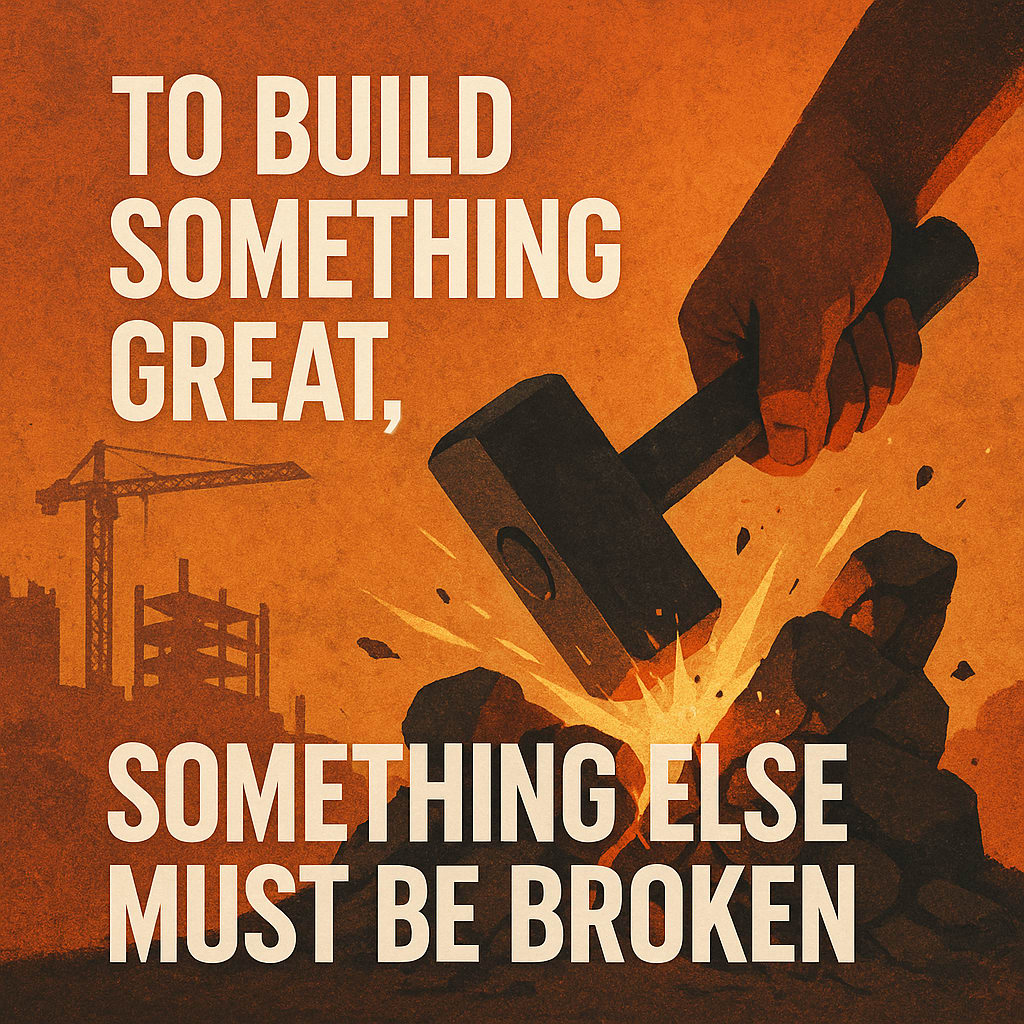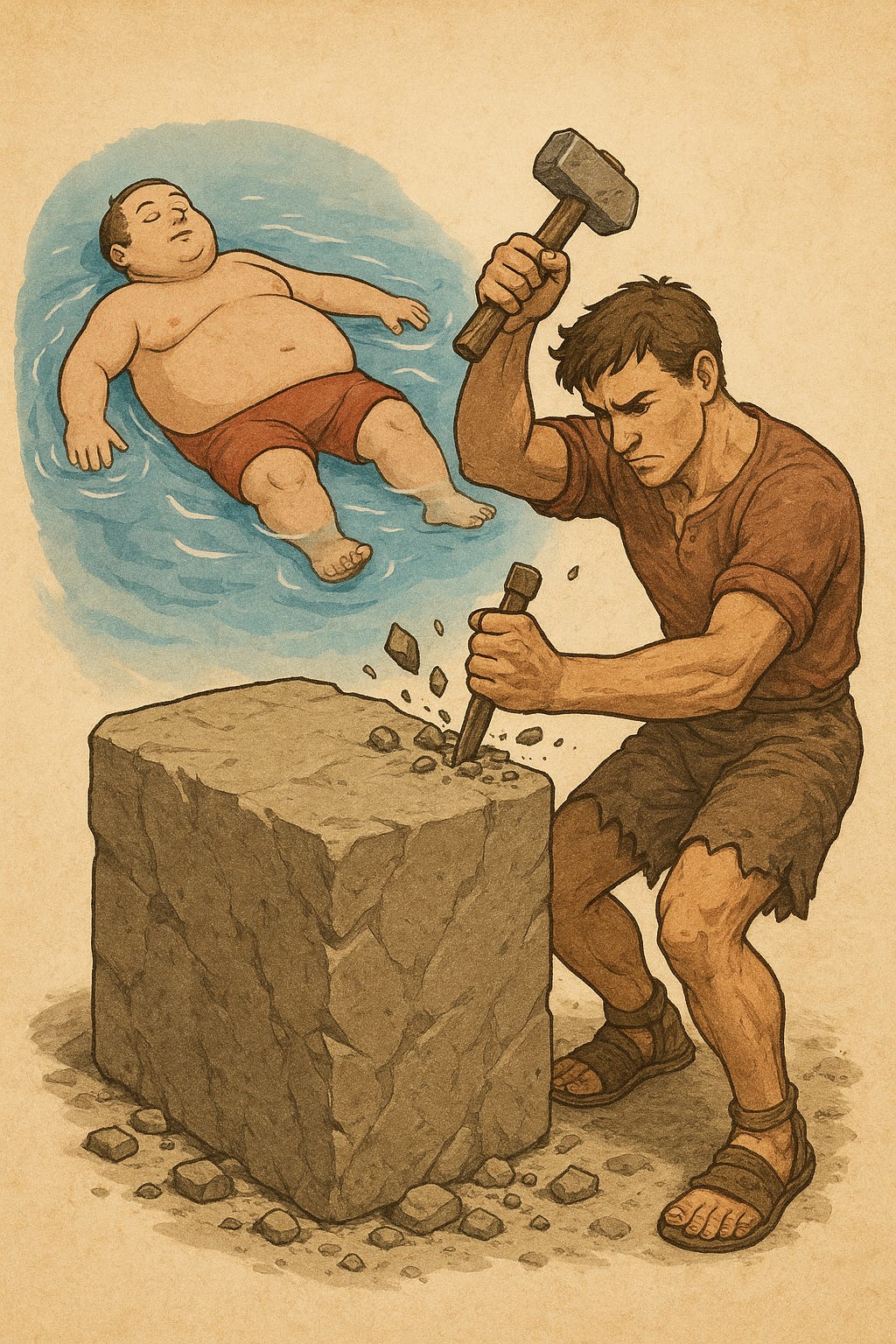To Build Something Great, Something Must Be Broken
Malik Stalbert, PhD
The universe has a law etched into its bones: nothing great is ever created without something breaking first. It’s not just a metaphor—it’s physics, biology, history, and story all woven together.
Biology: The Body as a Teacher
When you lift a weight, you’re not making your muscles stronger in that moment. You’re tearing them. The weak fibers fray under the pressure, the micro-tears sting, and your body responds by repairing them thicker, tougher, and more capable than before. Without that breaking, there is no growth. To seek strength without strain is like demanding a harvest without planting seeds in torn-up soil.
This principle doesn’t stop at muscles. Bones, too, adapt through stress. A runner’s bones grow denser under repeated impact, preparing to endure greater miles. The heart itself strengthens when pushed by exercise, pumping more efficiently and building endurance from the challenge. Even the brain plays by this rule—neuroplasticity is born from friction. New skills, languages, and patterns of thought carve themselves into the mind only when old pathways are challenged, stretched, and sometimes broken down.
Our biology is not built for ease. It is built for adaptation. Stress, soreness, and fatigue—these are not signs of weakness; they are signals of construction. The ache you feel after training is proof that the body is mid-renovation, laying new bricks where the old walls cracked. To avoid strain is to deny your body its blueprint for progress.
Think of what happens when you deny this truth: a body kept too long in comfort begins to atrophy. Muscles shrink, bones thin, and lungs weaken. Comfort corrodes. Strain sustains. Nature has already written the contract—life grows stronger only under pressure.
The Universe: Stars and Collapse
Our cosmos follows the same script. Stars die violent deaths, collapsing under their own gravity, only to scatter their guts across space. Those guts—iron, carbon, oxygen—are the very elements in your blood, bones, and breath. Even galaxies collide, ripping each other apart, and yet from the chaos, new order emerges. Creation and destruction are not enemies; they are partners in the same dance.
Learners and the Easy Escape
Yet when it comes to personal growth, too many of us resist the break. I’ve seen learners quit at the very moment they were about to grow:
The student who shuts their math book, saying, “I’m just not wired for numbers,” when in reality their brain was stretching, rewiring, breaking old patterns to make room for new ones.
The tennis player who wants to be a pro but refuses to miss shots in practice, not realizing that missed shots are the tuition for skill.
The coder who closes their laptop after one error message, declaring, “This isn’t for me.” They run from the very friction that could sharpen them.
Like water, they find the easiest escape route. And in doing so, they weaken themselves for future challenges. The time that should have been spent building resilience is spent searching for comfort.
Imagine two land dwellers who discover water. Both step into a lake and feel the stress of gravity fade away. Floating is easy, soothing. One of them says, “This is where I belong. Why would I ever leave?” The other says, “This is good recovery, but if I want to thrive on land, I must still train on land.” Over time, the one who stayed in the water grew weaker on land—bones softened, muscles lost their edge, balance faded. The other, who endured the strain of land but used the water to rest, became stronger, adaptable in both worlds. The lesson is clear: comfort zones restore you, but they cannot be your home. Stay there too long, and what once healed you will hollow you. We even see this in pop culture—think of Wall-E, where humans in space grew soft and fragile from floating in comfort, while the very gravity of Earth they abandoned was the one thing that could keep them strong. Ease gave them survival, but stripped them of resilience. Or take One Punch Man: Saitama only became the strongest hero after relentless, grueling training—pushing his body through pain and monotony. The villains he faces often had power handed to them without struggle, and though flashy at first, they crumble under true pressure. Both stories remind us: without strain, there is no staying power.
History: Break to Rebuild
History is a record of this truth. Rome burned, and from its ashes the Renaissance eventually bloomed. Civilizations rise, fracture, and are reborn in new forms. Even revolutions—American, French, Industrial—required breaking entrenched systems before anything new could be built. To pretend otherwise is to deny the pattern of progress.
Sci-Fi and Anime: Lessons in Fiction
Our stories echo this law because deep down we know it’s true:
In Dragon Ball Z, Goku only reaches new forms—Super Saiyan, Ultra Instinct—by pushing past his body’s limits, breaking in battle, even dying, before returning stronger.
In Star Wars, the Jedi are forged not in ease but through trial, often failing spectacularly before they can truly wield the Force. Luke Skywalker had to lose his hand—and his illusions—before he could rise as a Jedi.
In Attack on Titan, the walls don’t just protect; they crumble. And in that collapse, the characters are forced to grow, to face the terrifying truth of their world, and evolve beyond their former selves.
In The Matrix, Neo literally dies before he becomes “The One.” Death—the ultimate break—is the doorway to his transformation.
Pop culture isn’t just entertainment; it’s myth retold. And myths have always been humanity’s way of whispering the universe’s truths back to itself.
The Choice: Quit or Break Forward
There is a truth in knowing when to quit, yes. Some paths truly aren’t yours. But there is a deeper truth in failing while trying. To fail with full effort is not really failure—it’s transformation. Each stumble is a crack where new strength seeps in.
The student who endures confusion becomes the master who teaches clarity. The athlete who loses ten matches in a row is the one whose eleventh win feels like destiny. The creator who endures rejection letter after rejection letter is the one who eventually signs their name to something timeless.
The universe itself is forged in pressure, collapse, and rebirth. To expect greatness without breaking is to demand the impossible.
And remember this: the future will come whether you prepare for it or not. Do not be the one who looks back and says, “I wish I had embraced small failures when I was younger, instead of facing massive mistakes later.” Life gives everyone a capacity for challenges. You can face them early, when they build you, or later, when they break you. If you spend your early years running from struggle, you’ll only discover too late that your untested self is not ready for the weight of real life. Better to stumble now, to take the hits while they make you stronger, than to arrive at tomorrow wishing you had trained for its battles.
So when tension comes, when the walls shake, when your effort feels like it’s tearing you apart—don’t run. Lean in. Because to build something great, something must first be broken. And that something might just be you, reshaped into who you were meant to become.



